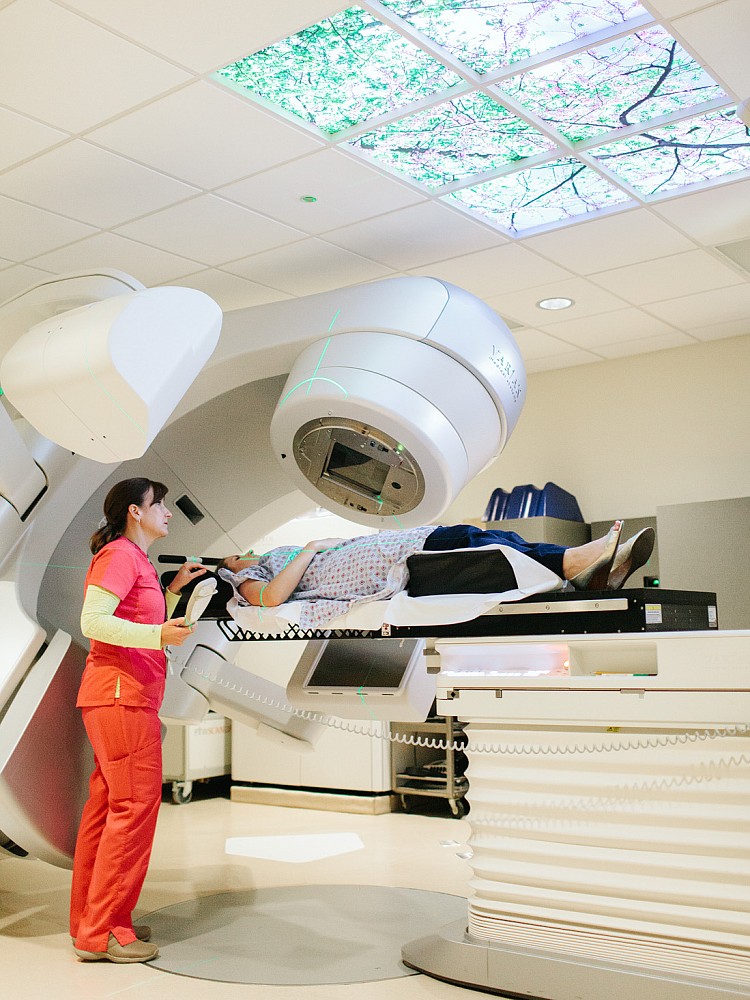
Northeast Georgia Medical Center offers cancer patients the latest technology and most advanced radiation therapy treatment options – in several convenient locations: Gainesville, Braselton and Toccoa.
In addition to a group of expert physician specialists, NGMC also provides detailed, comprehensive care and follow-up involving:
- Oncology certified nurses
- Registered radiation therapists
- Board certified physicists
- Board certified medical dosimetrists
- Oncology patient navigators
- Registered dieticians
- Cancer rehabilitation
Pre-Treatment Services
Prior to treatment, a consultation will occur. Additionally, your care team will review your records, discuss your case and treatment options.
A CT scan of the body area to be treated with radiation. The CT images acquired during your scan will be reconstructed and used to design the best and most precise treatment plan for you. Simulation is a critical preparation step before radiation treatment. During the simulation, the treatment setup is simulated by positioning you on a flat tabletop and when needed, customized immobilization devices will be created.
A gating CT allows for the analysis of motion from breathing. It provides information on the true shape of the anatomical objects in motion, decreases distortion, and identifies the range of motion to help make radiotherapy planning assessment more precise.
- Used alongside radiation therapy to limit radiation exposure to the heart and lungs
- Treatment is delivered during short periods in which the patient holds his or her breath
- Particularly useful in treatment of breast, chest or abdominal tumors
- Uses image guidance to place small metal objects called fiducial markers in or near a tumor in preparation for radiation therapy
- The markers help pinpoint the tumor’s location with greater accuracy, allowing for the maximum radiation dose to the tumor while sparing healthy tissue
- Hydrogel spacers used to protect the rectum for treatment. This is typically used for prostate cancer but may be used in other cancer sites.
Treatment Options
In addition to conventional 3D conformal therapy and electron beam therapy, we offer state-of-the-art treatment methods, including:
- Three-dimensional conformal radiation therapy (3D CRT) is a form of external beam radiation used to treat cancers in many parts of the body.
- 3D CRT utilizes radiation beams that are shaped to enter the patient from multiple angles in such a way that it spares as much healthy tissues as possible.
- A controlled dose of external beam radiation that allows treatment in sensitive areas
- Delivers high doses of radiation in a very precise way. It sculpts the dose to best align it with the target
- Spares more of the surrounding healthy tissue
- Fewer side effects as compared to traditional external radiation therapy
- VMAT is a form of IMRT where the dose of radiation is applied to the tumor by continuous rotation of the treatment unit.
- The dose distribution is precise with the shaping and adaptation of the dose to the form of the tumor.
- Allows treatment to be delivered in a shorter time compared to conventional IMRT
- Enables physicians to target tumors with great accuracy
- Provides ability to adjust the radiation beam to the tumor’s exact location
- Can spare more healthy tissue
- Applicable for some prostate, abdominal, lung, head and neck and brain tumors.
Brachytherapy is delivered as either a high dose rate (HDR) form or a low dose rate (LDR) depending on the duration and intensity of treatment. Both forms limit the amount of healthy tissue exposed to radiation.
- HDR is commonly used for gynecological, prostate and skin cancers. Treatment Involves temporarily inserting the source of radiation directly at or very near the tumor site
- Prostate seed implants are a form of LDR. They are radioactive pellets permanently placed within the prostate. This is one standard option for prostate cancer.
- If used, it is typically used after a course of external beam radiation
- Creates low-intensity electric fields, called Tumor Treating Fields (TTF), which help slow or stop glioblastoma cancer cells from dividing (and may also cause some of them to die)
- Uses adhesive patches, called transducer arrays, to deliver therapy
- These transducer arrays are applied to the scalp and are connected to the device and battery
- Uses imaging guidance to place small metal objects called fiducial markers in or near a tumor in preparation for radiation therapy
- The markers help pinpoint the tumor’s location with greater accuracy, allowing for the maximum radiation dose to the tumor while sparing healthy tissue
- Continuously monitors the body’s motion during a patient’s normal breathing cycles
- Ensures radiation is delivered only when the tumor is in exactly the right place
- Allows for treating smaller volumes to high doses, while also minimizing unnecessary exposure to normal, surrounding tissues
- Delivers a focused high dose of radiation to the tumor, allowing for fewer treatments than traditional radiation therapy
- Targets small, well-defined tumors with extreme precision
- Three-dimensional imaging is used during treatment to locate and target the tumor for precise delivery of radiation
- Can be used as an alternative to surgery in some cases
In addition to the radiation therapy treatments above, NGMC also offers medical and surgical oncology, patient navigation as well as other support services and access to national clinical trials. Click here for a list of current clinical trials offered at NGMC.

